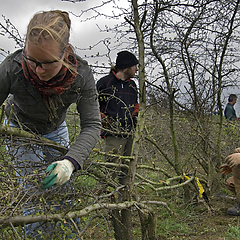Grassland irrigation is a form of agricultural technology, whereby grasslands are artificially fertilised by running water with lime and minerals from rivers, streams and springs. With the help of the smallest height differences and an ingenious system of ditches and locks, the water flows over the meadows, creating a rich grass landscape. The aim is to stimulate grass growth in order to ultimately harvest as much high-quality grass/hay as possible.
In the Netherlands, this is still done in two areas: on the 'Pelterheggen' in North Brabant and on 'the Lankheet' in Twente. The maintenance activities on the system are carried out in an annual rhythm, whereby the water keeps constantly moving.
There are different watering schedules for winter, spring and early summer. It becomes very interesting when, due to weather conditions (that is: too much or too little water), there is close cooperation needed with local recreational boating, water mills, farmers' interests or the water board. Then schedules have to be adjusted. These are discussed and debated. Cohesion is a key concept in irrigation.
When grass growth has started, the flow fields are mowed. This is done very carefully, with specially equipped machines, to prevent damage such as rutting and soil compaction. Mowing is specialist work due to the small areas per field, with awkward angles, height differences and the limited turning possibilities. The professional mowing or harvesting of flowery grassland is also important for successful grassland irrigation. On 'the Lankheet', this is done by a SKAL certified dairy farm that uses it to feed the cows. On the Pelterheggen, mowing is done under own management.
See: www.natuurmonumenten.nl/natuurgebieden/de-plateaux and www.hetlankheet.nl



